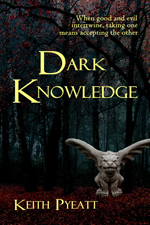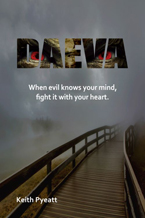Keith Pyeatt is an engineer turned novelist who writes paranormal thrillers with a psychological twist that he calls “horror with heart.” Living for ten years in an isolated cabin in Vermont may have influenced his choice of genre, but his empathetic nature is what helps him create a variety of characters — “likeable, despicable, tortured, and those ‘gray’ characters you can’t quite decide whether to love or hate.” Keith has four published standalone novels including Struck, Dark Knowledge, and Above Haldis Notch, with Daeva (October, 2015) being his most recent. You can find him on Twitter, Facebook, and his website KeithPyeatt.com.
 What is your elevator pitch for Daeva?
What is your elevator pitch for Daeva?
Daeva pits supernatural manipulation against human devotion when a powerful demon with a grudge against mankind stands ready to gain access to the world.
What sparked the initial story idea for the book?
My working title was Imagination, and my plan was to write a novel that showed how a strong paranormal influence would change different characters over the years. I decided a young boy would receive what appeared to be a great gift: a friendly entity who lived inside the boy’s mind and could grant him the power to make things happen. The boy accesses the power by using his imagination, which is fun and exhilarating at first, but the “gift” is actually a demon with his own agenda. The storyline expanded quickly as I wrote the first draft and developed the different characters’ motivations. The initial idea that sparked the novel is still there, but it became a launching point for a much more intricate plot.
Tell us about your main protagonist, his flaws and strengths, and the hurdles he tries to overcome.
Chris was raised to host a demon in his head, an upbringing which gave him some interesting personality defects. He’s inherently a good guy, and his sister Sharon helps pull out his best side, but he keeps many secrets and doesn’t allow anyone to get too close, partly out of need, partly out of habit. Unfortunately for Chris, even a lifelong commitment to being fair and strong can become a character flaw when a demon knows your every thought, desire, and need. And this particular demon has thousands of years of experience manipulating men, and he can dangle a mighty big carrot in front of his host to help lead him astray.
Why did you decide to use the particular setting(s) you chose?
For the macro-settings, Connecticut gave me elements I needed for a general location, and the time period seemed to take care of itself. I went into the past to set up a history for the daeva and moved forward from there. About three-quarters of the novel takes place in late 1992 and early 1993.
The micro-settings were really the key to creating atmosphere in Daeva. Minnie’s cabin in the woods gave me a combination of beauty and eeriness as well as the atmosphere of cold isolation and loneliness that I needed in Part 1. Rowena’s cluttered little house became the next important setting. It helped create the right atmosphere while characters frantically worked to piece together information and plot a course of action. A rural wooden bridge spanning a stream added an atmosphere of danger and mystery to the ending.
 Of the four novels you’ve published, which one did you enjoy writing the most? Who is your favorite character?
Of the four novels you’ve published, which one did you enjoy writing the most? Who is your favorite character?
I liked editing Daeva the most (good thing!), but I enjoyed writing the first draft of Dark Knowledge the most. It just poured out of me, and it showed me how fun it is to create complicated and engaging “gray characters,” the ones you can’t quite hate and can’t quite love. Lydia is my favorite character in that novel, and if there ever was a gray character, it’s her. She comes across as completely despicable initially, and she definitely enjoys her evil moments throughout, but there’s more to her than is shown in those early chapters. A great joy I have is when someone finishes reading the novel and tells me, almost reluctantly (as if they expect me to be disappointed) that they don’t hate Lydia. A little voice inside me yells WooHoo!
What is your writing routine like? What is your writing process like?
I write in long stretches. Ideally, I like to write every day, but sometimes reality interferes with creating fiction. My process is to start by creating some primary characters and a rough outline (with an ending). I write a first draft that’s loose and sloppy. It will wander. There will be repetition, inconsistencies, time frame problems, and gaping plot holes. There will be a huge number of typos, weak sentences, clichés, and vague notes like “fill in details” or “modify motive” or “fix time frame.” Sometimes I back up and change something to keep the first draft moving toward the ending (or revised ending) I have in my head, but I try to keep moving forward. I keep notes as I write so I’ll have an outline of what I actually wrote that’ll be more accurate than the outline of what I had planned to write.
I always edit novels start to finish, then I begin again. First edits are slow, with a lot of fresh writing and rewriting and deleting chunks of text. Successive edits tighten things up, and after several edits, they start going faster, which is important to get a good feel for the novel as a reader. I keep editing until I’m happy. Then I go away for a while, come back, and find myself shocked with the number of new things I find to fix and old problems that still need attention. When I can leave the novel alone for a while, come back, and still feel good about it, I’m getting near the end. Only a few dozen more edits to go. *smile*
If you suffer from writer’s block, how do you break through?
I’m of the mindset that you don’t wait for inspiration; you go after it…with a club. When writing a first draft, I generally muscle through a “block.” I’m not afraid to write something I’ll later delete or rewrite. It’s important to me to keep the process going, and I’ll usually stumble onto something that works if I keep hammering away. In editing, if I just can’t seem to make a paragraph or section flow and convey what I want, I’ll take a break for a few hours to workout, run, hike, play with the dogs, read, or do some project around the house.
What advice do you have for beginning or discouraged writers?
Write what you enjoy writing (which is probably what you enjoy reading), even if it’s not currently a hot-selling genre.
To learn more about Keith and his writing, including what he’s working on now, go to Part 2 of “An Interview with Author Keith Pyeatt” on klwagoner.com.
 KL Wagoner (writing as Cate Macabe) is the author of This New Mountain: a memoir of AJ Jackson, private investigator, repossessor, and grandmother. She has a new speculative fiction blog at klwagoner.com and writes about memoir at ThisNewMountain.com.
KL Wagoner (writing as Cate Macabe) is the author of This New Mountain: a memoir of AJ Jackson, private investigator, repossessor, and grandmother. She has a new speculative fiction blog at klwagoner.com and writes about memoir at ThisNewMountain.com.



